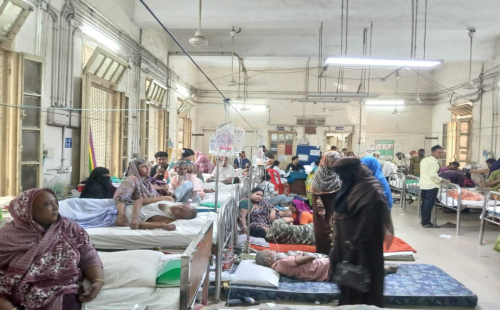Demystifying the remittance surprise

There is a surge in remittances
through formal channels, a surge that has belied all projections of a severe
downturn due to the pandemic.
Remittances in July-January grew
33 per cent (year-on-year) in Bangladesh this fiscal year.
The World Bank projected a 20
per cent decline in global remittances in 2020 due to the economic downturn
induced by the pandemic.
This apparently did not happen
and not just in Bangladesh.
Remittances through formal
channels surged in Nepal, Pakistan and Sri Lanka as well.
A micro-macro paradox
The story unfortunately does not
end there. At the micro-level, the facts on remittance appear quite different.
A survey released in January by
the South Asia Network on Economic Modelling (SANEM) finds the loss of this
crucial financing lifeline for many households.
They interviewed 5,577
households, distributed across 8 divisions and 64 districts, between
November-December 2020.
Over 82 per cent of households
who receive remittance from abroad reported receiving less than what they used
to receive before the pandemic.
Earlier in July, a survey by the
Refugee Movement and Migration Research Unit (RMMRU) covering 200 families of expatriate
workers from 21 districts found about 61 per cent of the families did not
receive any remittance over the preceding three months.
The amount of remittance the
remaining 39 per cent of the families received declined from an average of Tk
47,000 per quarter in normal times to Tk 30,000.
Information collected from the
households reflect better the total amount of remittances received irrespective
of whether these came through formal or informal channels.
Based on this evidence, it is
reasonable to assume that the size of remittance inflow to the households has
declined.
The apparent disconnect between
the macro and micro level are not “alternative facts”. They can both be correct
at the same time. The missing link is a major shift in channels migrant workers
use to send remittances.
Weaker remittance fundamentals
Consider the fundamentals
first. Total remittances depend on the
capacity and willingness to remit on the part of individual migrant workers and
the total number of such workers abroad.
The capacity to remit at the
level of the individual workers depends on their savings, which, in turn,
depends on their earnings and costs of living.
The willingness depends on the
strength of altruistic linkage, family needs and incentives such as the
exchange rate and interest rates.
The number of workers abroad
depends on job opportunities in host countries vis-à-vis the home economy and
the costs of migration.
What changed among these
fundamentals and in which direction?
Migrant workers tend to be more
vulnerable to loss of employment and wages during an economic crisis in a host
country.
The Persian Gulf hosts 70 per
cent of Bangladeshi migrants.
As Covid-19 began spreading
across the Gulf, working conditions of migrants deteriorated.
Millions of migrant workers
found themselves abruptly deprived of income, and in many cases, trapped in
crowded accommodations with little access to health care or even food.
In general, their economic,
legal and social lives were disrupted.
Many migrants retreated from
supporting families back home to feed themselves and keep off the streets.
The vulnerabilities of the
migrant communities remained even as the GCC nations transitioned toward
reopening.
Several regained employments on
a contingent or contractual basis, with even less security than the
pre-pandemic arrangements.
Many migrant workers were in
construction planned in accordance with high oil prices that were no more. Many
projects were postponed.
More than 18 million full-time
jobs were lost in this region between March and September of last year.
Migrant workers mostly faced a
decline in working hours, wages and business opportunities globally.
Costs of living at best remained
stable. Hence, saving at the individual level is unlikely to have increased for
most migrant workers since the virus raged in early 2020.
Some migrant workers may have
prospered benefitting from the increase in demand for workers in e-commerce and
other industries because of the pandemic.
Business closures due to
lockdowns led to a boom in online shopping and home delivery.
Migrant workers stepped in to
fill the void left by locals reluctant to work in logistics and distribution
due to fear of infection.
But these were of the order of
magnitude smaller than the jobs and income losses caused by the restrictive
effect of the pandemic on economic activities in the host countries.
The number of workers abroad
declined.
About 4.8 lakh migrants returned
in 2020, according to data provided to the parliament by the minister of
expatriate welfare and overseas employment.
Manpower export faced a sudden
stop since March and is yet to recover.
Bangladesh is used to exporting 40,000-50,000 workers per month in
normal times.
Decline in the number working
abroad and the increased fragility of incomes of those who remained can explain
the decline in total remittances reported by the households.
Indeed, remittances through the
formal channel in March-April plummeted to $1.2 billion a month from $1.6
billion per month in the preceding eight months.
A surprisingly sharp recovery
From a recent low of $1.1
billion in April, remittances through the formal channels rose sharply, peaking
at $2.6 billion in July and subsequently averaging about an unprecedented $2
billion per month through January 2021.
The recovery in May-July
benefited from several enhancements through formal channels.
The sharp drop in remittances in
March and April 2020 was partly due to restrictions on mobility.
Many remitters rely on
physically visiting remittance service providers.
International money transfer was
disrupted during the peak of lockdowns in March-April.
Easing of restrictions unlocked
these pent-up remittances leading to catch up subsequently.
In addition, those already
returned or in the returnee pipeline, estimated at 1.4 million by Brac,
DataSense and Unnoyon Shmonnoy, are likely to have brought back the accumulated
savings they did not remit home while working abroad.
Infrequent remitters who
transfer counter-cyclically during a crisis for altruistic reasons may also
have contributed.
The more secure Bangladeshi
diaspora abroad were better placed to send funds to relatives in Bangladesh in
response to the decline in family income at home due to the pandemic and
floods.
Migrants may also have remitted
home funds that could not have been spent on pilgrimage last year. May-July
spanned the two biggest Muslim festivals as well.
Transfer of accumulated savings,
unlocking of pent-up remittances, domestic economic distress, the Hajj and
festival effects cannot endure.
With the completion of the
return process, exhaustion of the pent-up stock and easing of domestic
distress, the inflows induced by these forces dissipated.
Yet, remittances from July
through January have remained elevated at around an unprecedented $2 billion a
month level, $400 million larger than the elevated pre-pandemic monthly average
in fiscal 2019-20.
The enhancement that seems to
have persisted is the diversion from informal channels as international trade
and travel, the backbone of demand for remittance dollars in the informal
market, struggled to get back to the pre-pandemic normal.
These continued to overwhelm any
decrease in remittances through formal channels by regular remitters with the
weaker capacity to save due to the pandemic.
The diversion accelerators
The rise in remittances through
formal channels had been remarkable in months preceding the pandemic.
The average monthly remittances
in fiscal 2018-19 were $1.4 billion.
This rose to $1.6 billion during
July-February in fiscal 2019-20.
The increase prior to the
pandemic was driven not just by the fundamental drivers such as growth in the
number of remitting workers but as importantly by substitution between
channels.
A 2 per cent subsidy on
remittances through banking channels introduced with the fiscal 2019-20 budget
made formal channels more attractive.
The entry of fintech services in
the remittance market expanded the reach of the formal channels.
Strengthening of the anti-money
laundering efforts by the government to comply with the Financial Action Task
Force (FATF) requirements made informal transfers riskier.
The pandemic pivoted the
diversion to formal channels further.
Informal channels include Hundi
networks as well as hand carrying.
Hundi networks transfer money
without any cash physically moving from one place to another.
Instead of going through the
traditional banking systems, these rely on retail establishments to collect
remittances overseas for paying out locally through money already in the
country.
The need for such transactions
evaporated as visa trade, under-invoicing imports and travel-based trade went
downhill due to the pandemic.
Limited travel during the
pandemic also made physical carry of cash difficult.
Drying out of informal channel
options forced sending money through banks, money transfer operators or mobile
platforms.
A correction likely, not
inevitable
The decline in the total
remittances (formal plus informal) is sobering from a growth point of view.
It drags private consumption,
the key driver of domestic demand.
Private consumption expenditure
depends on how much the households receive irrespective of the channels through
which they receive their money.
The increase in formal
remittances is an accounting artifact as the actual funds transferred are
lower.
However, the economic stability
metrics consider only official and formal flows which makes a redirection into
formal channels an important shift that does have an impact on macro-financial
stability.
The $2 billion level may persist
for a few more months. The underlying fundamentals supporting remittances are
currently weak.
Lower level of economic
activity, unstable oil prices, and suppressed demand for migrant workers in the
GCC region are likely to strain flows.
With the restoration in trade
and travel, the informal channels may swing back into action leading to a
reversal of the diversion from informal channels.
In that case, the monthly level
may regress towards the pre-pandemic $1.6 billion level.
This by no means is inevitable
partly because of the stickiness of change and largely due to changing outlook
over the longer term for migrant labour due to ageing in developed and emerging
markets.
GCC governments’ efforts to
reduce their dependence on migrants are limited by their population size, the
talent pool of locals and the availability of local young labour.
Reliance on migrant workers
might even increase with an expected rebound in economic growth globally as
vaccine role out approach herd immunity levels.
The author is an economist
Source: Dhaka Tribune
















